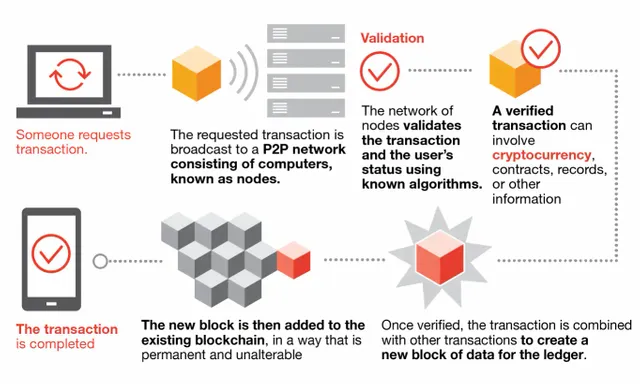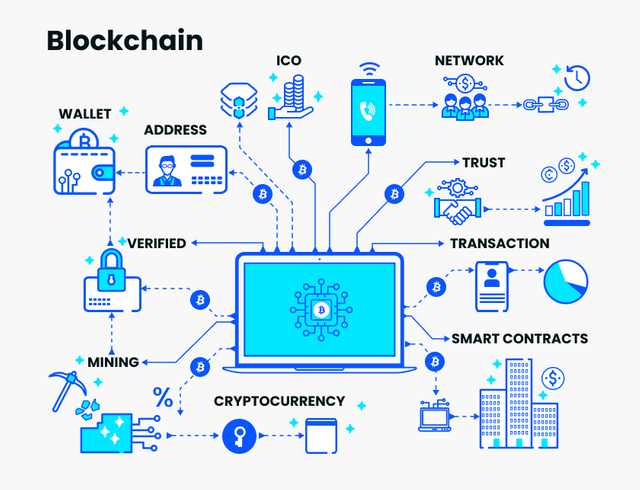Cryptocurrency and Blockchain
.jpg)
What is Blockchain?
A block is created by gathering all the encrypted information about money or asset transactions around the world over a period of time. A completely immutable decentralized and decentralized ledger sequenced into these blocks is basically called a blockchain. Everything seems blurry, right? Bitcoin is now known to many of us. An example of the blockchain we are talking about here is the Bitcoin blockchain. Bitcoin is a cryptocurrency managed by a blockchain.

Every branch has a large ledger that records all banking transactions. And banks that use banking software have this record in their database. Perhaps even in that old ledger. This large ledger is called the Ledger. Therefore, for a transaction to be valid, there must be an entry in the bank ledger. A blockchain is a ledger with many such blocks side by side. Each block contains all data from all transactions that have occurred in the world at one point in time. This data is public but encrypted. This means everyone can see this data, but you need your private key to read it. That is, if you made a transaction here, you can read all the information in the transaction using your private key here, and no one else can read it. But what people will see is the trading volume. But it is impossible to know whose money went to whom. Because money will only go through your address. There will be no identity.

The image below shows what the transaction looks like. Each block in the blockchain is completely immutable. Once a block is added to the chain, it cannot be changed. Blocks are placed side by side in the order of their creation. Each block knows which block is in front of it. So one block is connected to another block. Blockchain is a decentralized and decentralized system. That is, all users or specific users on the same blockchain worldwide have a copy. So if one or hundreds of servers or computers go down together, nothing happens to the blockchain.
Cryptocurrency:
Like our traditional currencies, cryptocurrencies are also a kind of currency or medium of exchange. This means that you can do the same things with cryptocurrencies that you can do with traditional currencies like dollars, pounds, rupees, etc. This cryptocurrency is used for transactions through blockchain technology. There are many currencies such as Bitcoin, BitCash, Monero, Litecoin, etc. Our currencies such as dollars, pounds, takas, etc. fluctuate in price from time to time, so these currencies, i.e. buy/sell prices fluctuate.
By now you probably understand what cryptocurrencies mean. Now let's discuss how cryptocurrencies work.

A cryptocurrency (e.g. Bitcoin) is like a network. Each peer has a full record of all transactions, so each account balance has a record. For example, the transaction file says "Shamsul gives Alice x amount of bitcoins" and is signed with Shamsul Haque's private key. This is basic public key cryptography. Once a transaction is signed, it is distributed across the network and sent from one peer to another. This is a basic peer-to-peer technology. The infographic below gives you an idea of how blockchain and cryptocurrencies work. Click on the photo to see it in a larger size.
Transactions are completed very quickly. However, after a certain period of time, it is confirmed. It's very similar to verifying by activating your account. This verification is very important in cryptocurrencies. As long as the transaction is uncertain, it is pending and can be counterfeited. When a transaction is confirmed, it is fully established on the ledger. It can no longer be edited or deleted. This means that you can no longer change the ledger information. This process is mainly done through the blockchain discussed above.
Only miners can verify transactions. This is essentially the job of miners in cryptocurrency networks. It receives transactions, stores them in the ledger, and distributes them to the network. When a transaction is confirmed by a miner, it becomes part of the immutable blockchain. Miners earn cryptocurrency tokens (called fees) for this work (e.g. Bitcoin). The activity of miners is the most important part of the cryptocurrency system, so we will try to learn about them.
.jpg)
All currencies in circulation are controlled by a country's government and central bank. A public or private central bank, such as the United States, can create a new currency depending on the country's economy and other factors. New 'notes' can be printed directly in Bengali. In other words, regulators can do whatever they want without caring about who wins and who loses. For example, inflation occurs because our country prints more money than it needs.
However, cryptocurrencies are created completely differently. Here, a new currency or Bitcoin is created every 10 minutes by competing to solve cryptographic puzzles. And this puzzle competition is done through miners.
For those of you who know about cryptography, the SHA256 encryption will be familiar. For those unfamiliar, that's it.
And if your data is encrypted with SHA256, you should know that you can use a hash for that data. For ease of understanding, the hash looks like "000001beeca3785d515897041af0a7". Now, if there's even a slight change in this data, we get another hash. This means that when encrypted in this way, the hash of a particular piece of data is always the same and is the same on everyone's computer.
The hash we used above now has 5 leading zeros. It's intentional. This is the cipher puzzle I was talking about earlier. Every minute there are countless transactions taking place on the Bitcoin blockchain around the world. After a new block is added to the blockchain, pending transaction data accumulates on every miner's computer in the Bitcoin system for about 10 minutes. The miners are ourselves and we mean we sit down with our computers to solve puzzles.
Now the goal of us or the miners is to convert the data we currently have to the hash of the previous block and another random number (we call this a random number here. Nonce = a number used once). Why these 5 zeros? This is called difficulty. That is, the number of zeros at the beginning indicates how difficult the puzzle is to solve.
So in no time thousands of miners around the world were racing to find the hash they wanted on their computers. This process cannot be defeated by any special algorithm or intelligence. In the Bengali way, a nonce or expression must be applied in turn to determine if a hash of that pattern exists.
The winner is the miner who can find this hash first. Finding a hash means creating a new block for a new blockchain. Isn't that cool? The task of the remaining non-winning miners is to verify the results of the winning miners. Therefore, when 51.7% of miners confirm, the new block is added to the blockchain as a confirmed or valid block.
There is a lot of discussion about cryptocurrency.
On the other hand, many people may have doubts about the security of cryptocurrencies. The future of all other cryptocurrencies, security and cryptocurrencies will be discussed in the next episode. I end here by inviting everyone to read the episode for today.
Reference:
- https://en.m.wikipedia.org/wiki/Cryptocurrency
- https://blockgeeks.com/guides/what-is-cryptocurrency/
- https://www.iayon.com/blockchain-bitcoin/
#fintech #thediarygame #science #technology #finance #crypto #business #computing #club5050 #club #club75 #club100
#communityintroduction #steemexclusive #steem4bloggers #steemgrowth #pakistan #steemit #science #fintech
Too much informative
Thanks
Greetings friend and welcome to the steemit platform. The first thing you have to do is to write your achievement 1 task before you will start posting in other communities. I advice you contact the person that introduce you to guide you.
ok. I'll try my best and Thank you so much for support.